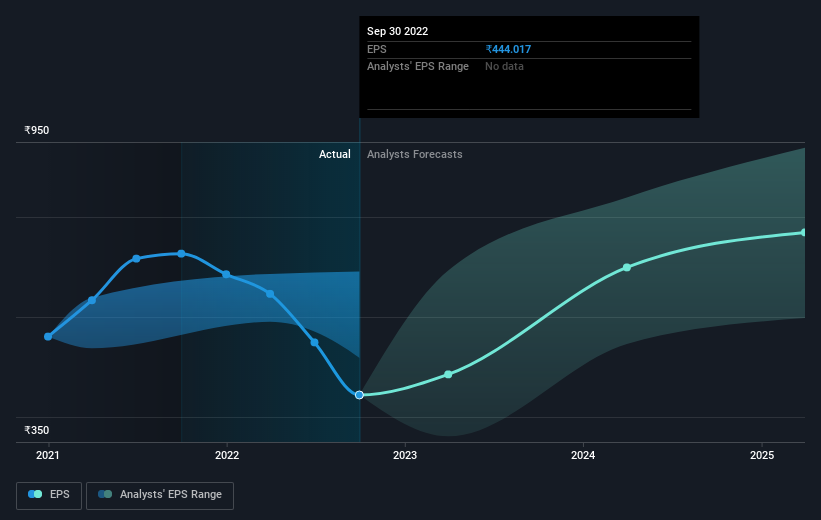[ad_1]
The main point of investing for the long term is to make money. Better yet, you’d like to see the share price move up more than the market average. Unfortunately for shareholders, while the Shree Cement Limited (NSE:SHREECEM) share price is up 36% in the last five years, that’s less than the market return. Zooming in, the stock is actually down 16% in the last year.
So let’s assess the underlying fundamentals over the last 5 years and see if they’ve moved in lock-step with shareholder returns.
Our analysis indicates that SHREECEM is potentially overvalued!
While markets are a powerful pricing mechanism, share prices reflect investor sentiment, not just underlying business performance. One way to examine how market sentiment has changed over time is to look at the interaction between a company’s share price and its earnings per share (EPS).
Over half a decade, Shree Cement managed to grow its earnings per share at 2.2% a year. This EPS growth is slower than the share price growth of 6% per year, over the same period. This suggests that market participants hold the company in higher regard, these days. That’s not necessarily surprising considering the five-year track record of earnings growth. This favorable sentiment is reflected in its (fairly optimistic) P/E ratio of 52.37.
The image below shows how EPS has tracked over time (if you click on the image you can see greater detail).

Dive deeper into Shree Cement’s key metrics by checking this interactive graph of Shree Cement’s earnings, revenue and cash flow.
What About Dividends?
As well as measuring the share price return, investors should also consider the total shareholder return (TSR). The TSR is a return calculation that accounts for the value of cash dividends (assuming that any dividend received was reinvested) and the calculated value of any discounted capital raisings and spin-offs. So for companies that pay a generous dividend, the TSR is often a lot higher than the share price return. As it happens, Shree Cement’s TSR for the last 5 years was 38%, which exceeds the share price return mentioned earlier. This is largely a result of its dividend payments!
A Different Perspective
Shree Cement shareholders are down 16% for the year (even including dividends), but the market itself is up 3.4%. Even the share prices of good stocks drop sometimes, but we want to see improvements in the fundamental metrics of a business, before getting too interested. Longer term investors wouldn’t be so upset, since they would have made 7%, each year, over five years. If the fundamental data continues to indicate long term sustainable growth, the current sell-off could be an opportunity worth considering. While it is well worth considering the different impacts that market conditions can have on the share price, there are other factors that are even more important. To that end, you should be aware of the 2 warning signs we’ve spotted with Shree Cement .
But note: Shree Cement may not be the best stock to buy. So take a peek at this free list of interesting companies with past earnings growth (and further growth forecast).
Please note, the market returns quoted in this article reflect the market weighted average returns of stocks that currently trade on IN exchanges.
Valuation is complex, but we’re helping make it simple.
Find out whether Shree Cement is potentially over or undervalued by checking out our comprehensive analysis, which includes fair value estimates, risks and warnings, dividends, insider transactions and financial health.
View the Free Analysis
Have feedback on this article? Concerned about the content? Get in touch with us directly. Alternatively, email editorial-team (at) simplywallst.com.
This article by Simply Wall St is general in nature. We provide commentary based on historical data and analyst forecasts only using an unbiased methodology and our articles are not intended to be financial advice. It does not constitute a recommendation to buy or sell any stock, and does not take account of your objectives, or your financial situation. We aim to bring you long-term focused analysis driven by fundamental data. Note that our analysis may not factor in the latest price-sensitive company announcements or qualitative material. Simply Wall St has no position in any stocks mentioned.
[ad_2]
Source link








